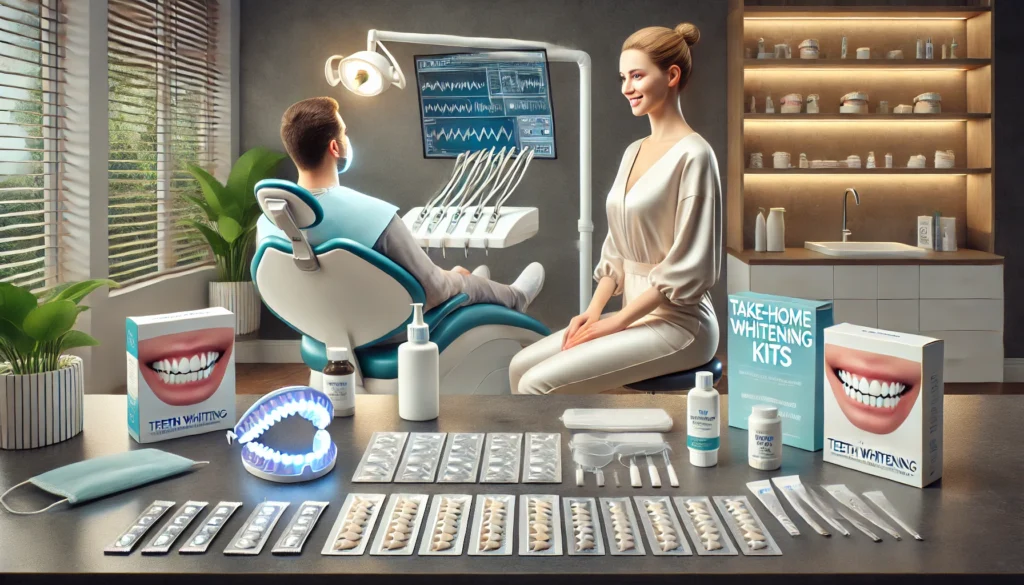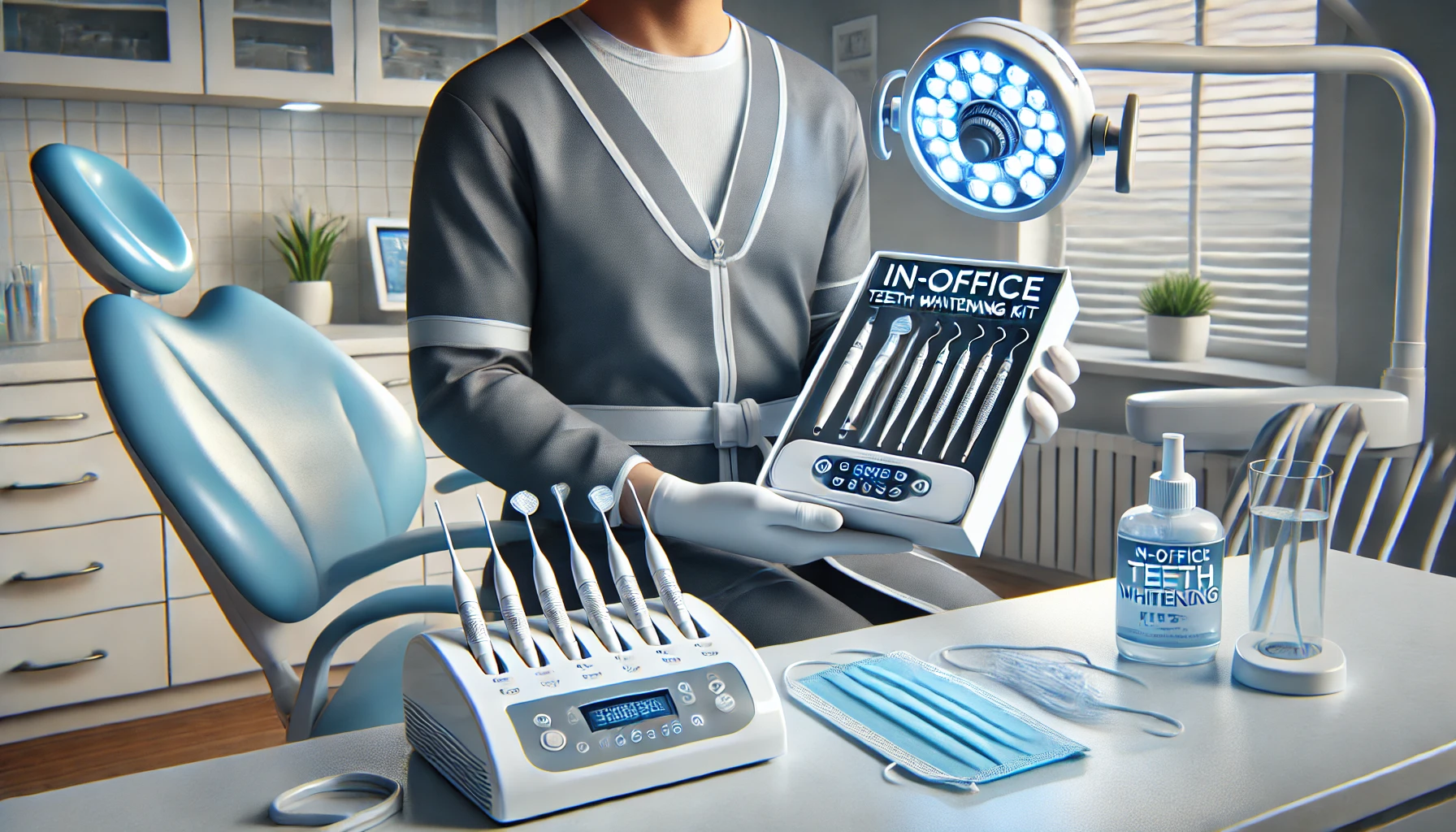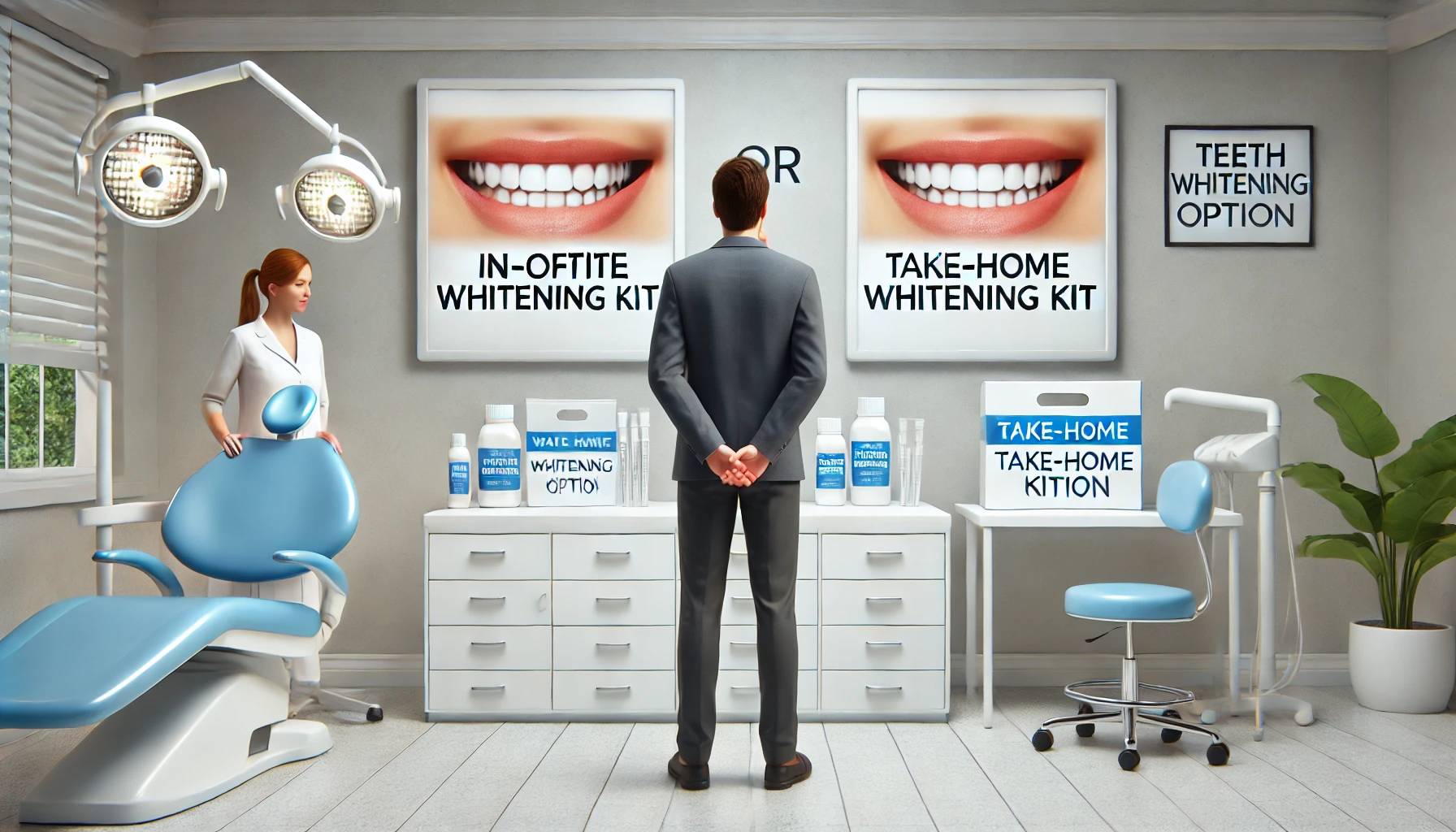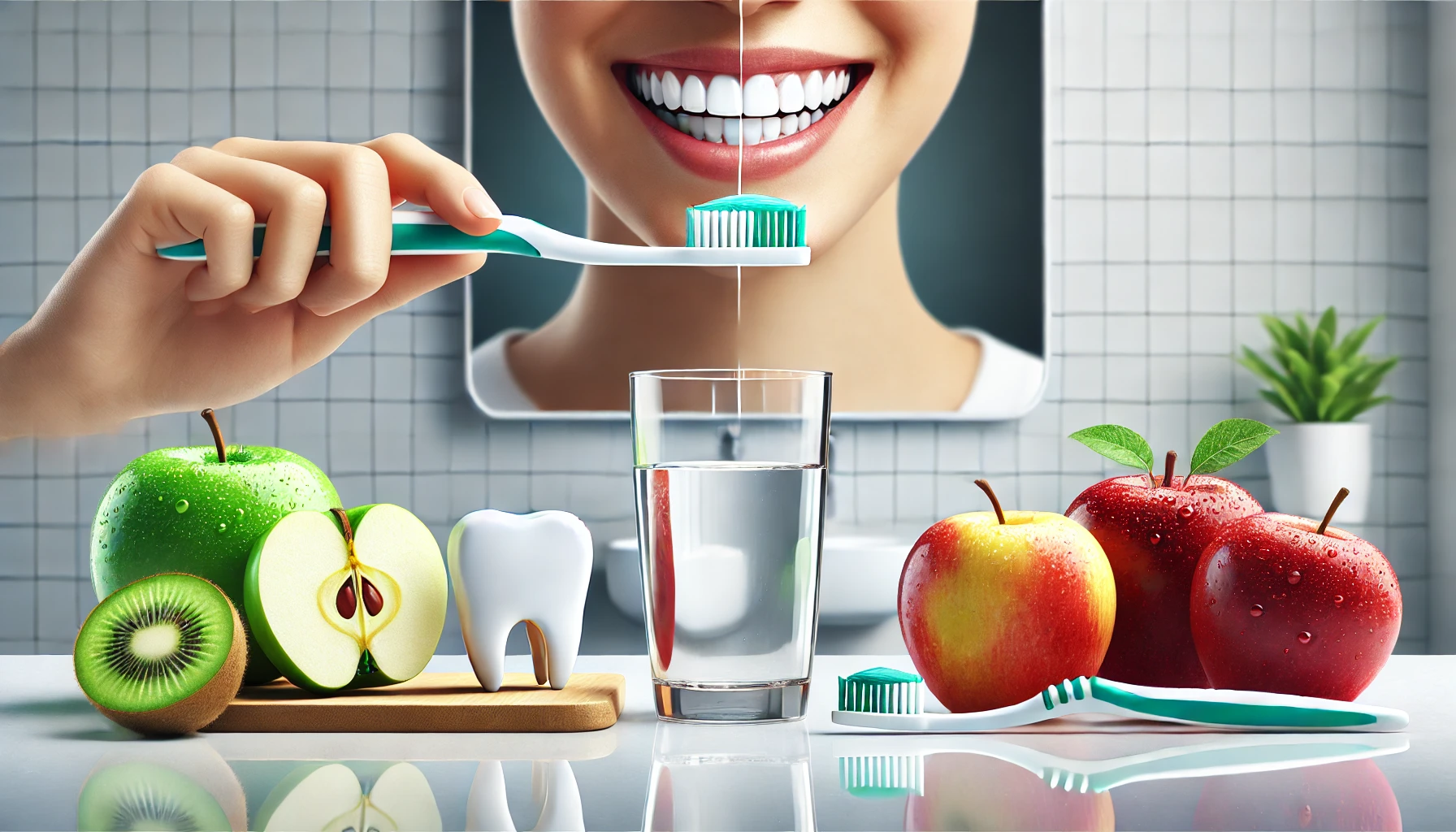
Teeth whitening has emerged as a widely accepted method for enhancing smiles and boosting confidence. With a range of options available—ranging from professional in-office treatments to convenient take-home kits—the process of selecting the most suitable method can feel quite overwhelming.
Understanding the Differences Between In-Office and Take-Home Whitening Kits
This article delves into the details of teeth whitening, explaining how in-office whitening procedures work while weighing their advantages and disadvantages against those of take-home alternatives. It aims to assist you in determining which option best aligns with your needs, discusses essential maintenance tips, and offers cost comparisons to help you achieve the dazzling smile you desire.
What Is Teeth Whitening?
Teeth whitening has become a widely sought-after cosmetic dentistry procedure, designed to enhance the brightness of one’s smile by eliminating stains and discolouration from the teeth.
There are several methods available, including:
- in-clinic whitening treatments
- take-home whitening kits
- over-the-counter products
Each of these approaches employs different bleaching agents, such as hydrogen peroxide or carbamide peroxide, to achieve the desired outcome. Although the effectiveness and duration of the whitening process can vary from one method to another, regular maintenance is crucial for ensuring that your teeth remain bright and healthy over time.
What Are In-Office Whitening Kits?

In-office whitening kits are professional treatments conducted by dentists to deliver quick and effective whitening results for individuals desiring a brighter smile.
These procedures generally involve the application of potent bleaching agents, such as hydrogen peroxide, under the careful supervision of a dental professional. Typically, the whitening process can be completed in just one appointment, making it a convenient option for those wanting to improve the colour of their teeth in a relatively short time.
Moreover, the dentist is able to monitor any sensitivity issues that may arise, ensuring both safety and comfort during the treatment.
How Do In-Office Whitening Kits Work?
In-office whitening kits utilise a concentrated whitening gel, usually containing hydrogen peroxide or other bleaching agents, to effectively remove stains from the teeth during a professional dental session. The dentist begins by assessing the patient’s tooth shade and then applies the gel directly to the teeth using custom trays or strips. This process allows the active ingredients to penetrate the enamel, resulting in noticeable improvements. Additionally, patients may benefit from advanced technologies, such as UV light or LED technology, which can further enhance the whitening process.
This professional approach prioritises safety and comfort throughout the treatment. During the initial consultation, the dentist engages in a discussion about the patient’s dental history, expectations, and any concerns they may have. This dialogue is crucial for developing a personalised treatment plan that meets individual needs.
Once the whitening gel is applied, appropriate protective measures, such as dental dams or lip protectors, are used to shield sensitive areas. The gel is generally activated by light for specific intervals, allowing for a controlled reaction while the dentist closely monitors the process.
After several sessions, patients can expect to see a significant improvement in the shade of their teeth. The results from in-office treatments tend to last longer than those from at-home kits, particularly when professional maintenance recommendations are followed diligently.
What Are the Pros and Cons of In-Office Whitening Kits?
In-office whitening kits present a range of advantages and disadvantages that potential patients should carefully consider before deciding on treatment.
On the positive side, these professional treatments often yield immediate and noticeable results, primarily due to the high concentration of bleaching agents used. Additionally, having a dentist supervise the process can help manage any side effects, such as tooth sensitivity, while ensuring a safe and controlled environment for the whitening procedure.
However, the cost of in-office whitening can be significantly higher than that of at-home kits, which may discourage some individuals from opting for this option.
While the immediate effectiveness of in-office whitening is certainly appealing, it is important for patients to assess their individual dental health and sensitivity levels beforehand. Some may experience discomfort during or after the procedure, making it essential to consult with a dental professional who can tailor an appropriate treatment plan.
Ultimately, individuals face a choice between convenience and financial investment, and being well-informed can lead to a satisfying outcome in achieving a brighter smile.
What Are Take-Home Whitening Kits?
Take-home whitening kits provide a convenient alternative to in-clinic treatments, enabling patients to whiten their teeth at their own pace and in the comfort of their homes. Typically, these kits come with custom trays and a whitening gel that contains bleaching agents such as hydrogen peroxide or carbamide peroxide.
Patients apply the gel over a specific duration to achieve gradual results. Many individuals appreciate the flexibility and ease of use that at-home whitening offers, making it an appealing option for those with busy lifestyles or for those seeking to maintain their smiles between dental appointments.
How Do Take-Home Whitening Kits Work?
Take-home whitening kits work by providing individuals with a whitening gel that they apply using custom trays specifically designed for their teeth. The user fills the trays with the gel and wears them for a recommended duration, often determined by their dentist, to gradually lighten stains and achieve the desired shade of whiteness. Many find these kits easy to use, as they can seamlessly integrate them into their daily oral hygiene routine, allowing for flexible whitening sessions that fit their schedules.
The application process is crucial for achieving optimal results. The custom trays are tailored to ensure a snug fit, maximising contact between the whitening gel and the surfaces of the teeth.
Following the dentist’s recommendations regarding the duration of wear is equally important; consistent use allows the active ingredients in the gel to penetrate the enamel and effectively reduce discolouration.
Users can typically anticipate noticeable results after several applications, often leading to a brighter smile that enhances their overall appearance. It is also worth mentioning that while some may experience mild and temporary side effects, such as tooth sensitivity, these are generally manageable and contribute to the overall convenience offered by these effective whitening solutions.
What Are the Pros and Cons of Take-Home Whitening Kits?
Take-home whitening kits present a range of benefits, as well as some drawbacks, that individuals should carefully consider when contemplating this whitening method.
One significant advantage is the convenience they offer, allowing users to whiten their teeth on their own schedule without the need for dental appointments. Additionally, these kits are generally more affordable than professional in-clinic treatments, making them an appealing option for many consumers.
However, it is important to note that results may take longer to achieve, and some users might experience sensitivity during the whitening process.
With options available both over the counter and through a dentist’s prescription, this method accommodates various preferences and budgets.
The effectiveness of these kits can vary, often depending on the ingredients used and how frequently individuals apply them. While many users report satisfaction with their results, it is crucial to understand that the gradual nature of these outcomes may not meet the expectations of those seeking immediate transformations.
Furthermore, heightened tooth sensitivity is a potential side effect that some individuals may experience, which necessitates finding a balance between the desired level of whitening and comfort during treatment.
Which Option Is Right for Me?

Deciding between in-office and take-home whitening options can be quite challenging, as each method presents distinct advantages suited to various needs and lifestyles. To simplify this decision, individuals should evaluate several factors, including their budget, time commitment, desired outcomes, and comfort level with the whitening process.
In-office treatments typically deliver quicker, more dramatic results under the guidance of a professional, whereas take-home kits offer flexibility and convenience, making them an excellent choice for those who prefer a more gradual approach.
Factors to Consider When Choosing Between In-Office and Take-Home Kits
When considering the choice between in-office and take-home whitening kits, several important factors come into play that can significantly influence your decision. It is essential to think about your budget, the speed at which you desire results, and the amount of time you can dedicate to the whitening process.
Additionally, personal preferences regarding comfort levels and the types of products used, such as hydrogen peroxide or bleaching gels, should also be factored into your whitening strategy.
The effectiveness of various whitening options can differ, so it is crucial to understand how each method aligns with your individual goals for achieving a brighter smile. Engaging with a dentist to create a personalised treatment plan not only provides a customised approach but also improves patient outcomes. Professionals can offer valuable insights into what will work best based on your specific dental health conditions.
While cost and convenience are significant considerations, they should not overshadow the importance of a user experience that emphasises health and safety. Prioritising these factors will foster long-term satisfaction with the results.
Cost Comparison of In-Office and Take-Home Whitening Kits
Understanding the cost comparison between in-office and take-home whitening kits is essential for individuals looking for effective yet affordable whitening solutions. In-office treatments typically carry a higher price due to the professional supervision involved and the immediate results they provide. In contrast, take-home kits are generally more budget-friendly, making them accessible to a wider audience.
It is important to evaluate the potential long-term benefits and maintenance costs in relation to the initial investment to determine the best option for one’s financial circumstances.
Generally, in-office treatments can range from £500 to £1,000 per session, depending on the provider and location. On the other hand, take-home kits usually fall somewhere between £100 and £300.
While in-office procedures provide instant results, their longevity may depend on the patient’s lifestyle and dietary habits, which could necessitate follow-up sessions that add to the overall costs.
Conversely, take-home kits may require consistent use over several weeks. However, many users find that their effects can last longer with proper maintenance, including regular touch-ups. This highlights the importance of patient education, as consumers must take into account both the initial costs and any potential future expenses when making an informed decision about whitening methods.
Effectiveness of In-Office vs. Take-Home Whitening Kits
The effectiveness of in-office whitening compared to take-home kits is often a key consideration for individuals looking to achieve whiter teeth. In-office treatments typically provide faster and more noticeable results, as they involve higher concentrations of bleaching agents administered under professional supervision.
On the other hand, take-home kits generally require a longer usage period to achieve similar outcomes. By understanding the expected results and the time commitment associated with each option, consumers can make informed decisions about which whitening method best suits their specific needs.
Several factors, such as the initial shade of one’s teeth and the frequency of application, significantly influence the overall effectiveness of either method. For individuals with severely stained teeth, professional treatments may be more effective, offering immediate results that can enhance confidence.
Conversely, those with less pronounced discolouration may find that take-home kits provide a sufficient solution for gradual improvement. It’s essential for consumers to be aware of the efficacy of different products; knowing which ingredients are effective can guide their choices, ensuring that their treatment plan aligns with their personal goals and lifestyle.
Personal Preference and Convenience
Personal preference and convenience play a crucial role in the decision-making process between in-office and take-home whitening options, as each method caters to different lifestyles and comfort levels. Some individuals may favour the quick results and professional setting offered by in-office treatments, while others might enjoy the flexibility and ease of using take-home kits at their convenience.
Evaluating one’s daily routine, comfort with dental procedures, and desired outcomes will aid in determining which option best meets personal needs.
For example, those with busy schedules may gravitate towards the adaptability of at-home kits, allowing them to whiten their teeth during downtime, such as while watching television or commuting. Conversely, individuals looking for an immediate visual transformation for special occasions might find in-office whitening more appealing.
The overall user experience can differ significantly; some may appreciate the guided professionalism of dental staff, while others might prefer the privacy and simplicity of self-administered treatments.
Ultimately, recognising these personal comfort levels can greatly influence the choice of whitening methods that align with specific lifestyles and treatment preferences.
How to Maintain Teeth Whitening Results

Maintaining the results of teeth whitening is crucial for prolonging the brightness of your smile after treatments. A consistent oral hygiene routine, which includes regular brushing and flossing, can significantly help in minimising stains and preserving the colour of your teeth.
Furthermore, scheduling regular dental check-ups and touch-up sessions—whether through in-surgery treatments or at-home kits—can ensure that your whitening results endure while also safeguarding your enamel from potential damage.
Tips for Maintaining a Bright Smile
To maintain a bright smile following teeth whitening, there are several proactive strategies you can employ to keep your teeth looking their best.
First and foremost, it is essential to uphold a diligent oral hygiene routine by brushing twice daily and flossing regularly. This practice will help remove plaque and prevent stains from developing.
Additionally, consider moderating your consumption of staining foods and beverages, such as coffee, tea, and red wine, as these can contribute to discolouration over time. Regular visits to your dentist for cleanings and check-ups are also vital for preserving both the brightness of your smile and your overall dental health.
Incorporating whitening toothpaste into your routine can offer additional polishing benefits, effectively targeting surface stains while also protecting your enamel. Staying hydrated is equally important; drinking water helps wash away food particles and reduces acid levels in the mouth.
Being mindful of your dietary choices is crucial as well. Opting for less acidic and non-staining alternatives can significantly aid in maintaining your whitening results.
Furthermore, utilising mouthguards or whitening strips designed for home use, under your dentist’s guidance, can help prolong that radiant smile while ensuring enamel safety.
Taking a holistic approach to your dental care will not only ensure lasting brightness but also promote long-term dental health.
Recommended Touch-Up Schedule
Establishing a recommended touch-up schedule is essential for maintaining the results of your teeth whitening treatments over time. Depending on the whitening method you choose, you may need to refresh your results every few months to a year.
For individuals using take-home kits, dentists often suggest using these kits periodically to prevent staining and ensure that your smile remains bright and vibrant. Regular consultations with your dentist can help determine the most suitable touch-up frequency tailored to your unique dental care needs and lifestyle.
Several factors can influence how often one should schedule these touch-ups. Personal habits, such as smoking, consuming staining foods, or drinking beverages like coffee and red wine, can lead to faster discolouration, making more frequent treatments necessary.
Those who have undergone in-office whitening may find that their smiles require less maintenance compared to those who rely solely on at-home methods. Understanding the type of whitening system employed is crucial in developing a personalised maintenance plan.
Ultimately, prioritising these touch-ups is vital not only for aesthetic appeal but also for ongoing dental health and comprehensive care.
Frequently Asked Questions
What are the main differences between in-office and take-home whitening kits?
The main difference between in-office and take-home whitening kits is the location in which the whitening treatment is performed. In-office whitening is done at the dentist’s office, while take-home kits allow the treatment to be done at home.
How long does each type of whitening treatment take?
In-office whitening typically takes around 1-2 hours, while take-home kits require multiple sessions of 30 minutes to an hour each.
Which option is more expensive?
In-office whitening is usually more expensive than take-home kits due to the cost of professional equipment and the dentist’s time.
What are the potential side effects of each type of whitening treatment?
In-office whitening may cause temporary tooth sensitivity and gum irritation, while take-home kits may also lead to sensitivity and uneven results if not used properly.
Which option provides faster results?
In-office whitening typically provides faster and more dramatic results, as the treatment is done by a professional and uses stronger whitening agents.
How long do the results of each type of whitening treatment last?
The longevity of results varies for each individual, but in general, in-office whitening results may last longer due to the use of stronger whitening agents and the dentist’s expertise. Take-home kits may require touch-up treatments to maintain results.





